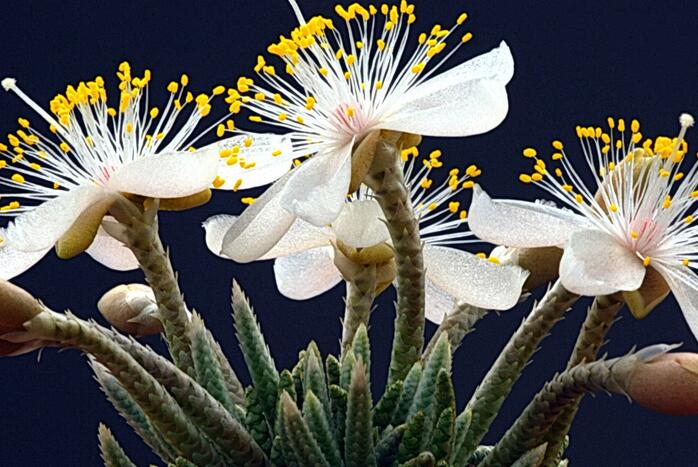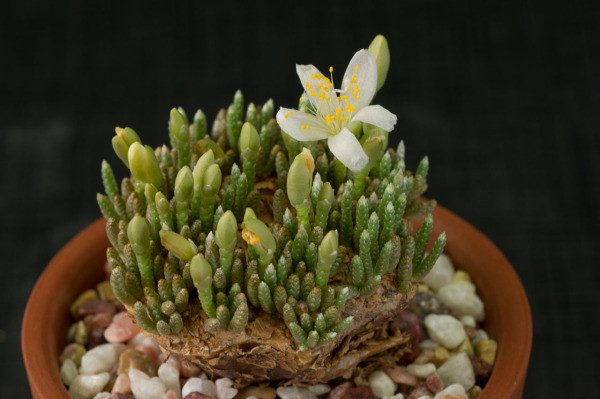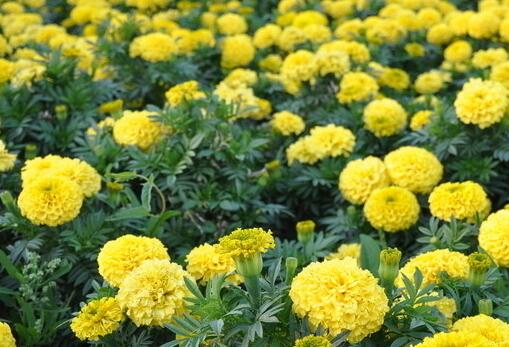What if the white flower does not blossom? when is it difficult to bloom?
White flower tough brocade like plum blossom, anther is light yellow, in the middle of white petals, showing bright and fresh vitality! However, such a "flash in the pan" delicate flowers are rare, even sometimes do not bloom, at this time, want to enjoy the "Silver Snake Flying Dance", but white flowers tenacious brocade do not blossom?

What if the white flower tenderness brocade does not bloom:
The florescence of White Blossom brocade is usually from May to July.
Because of its short flowering period and the short time that the plant was introduced into our country, the cultivation is not very common and few people have seen its flowers.
After the florescence of the white flower brocade arrives, it usually blooms in the sunny afternoon. At this time, the owner only needs to have enough patience to observe the changes and wait quietly.
When is it difficult for the white flower brocade to bloom:
Although Bengjin is known as "epiphyllum" in Portulacaceae, the editor believes that epiphyllum blossoms at night, and its owner can slowly wait for her arrival in the dark, but it usually blooms in the afternoon during the day. We often miss her beautiful moment because of some small things.
In case of cloudy and rainy days or cultivation environment lack of light or even difficult to open!
At this time, what the host needs to do is to put her in a place with good ventilation and the best light, and then wait for the surprise to come!
The white flower blooms in the afternoon and closes at night. The life span of each flower is only 4-5 hours. Such a short flowering period, let us cherish her beauty. Because there is not enough technology to support the conservation of white flower brocade in China, people who want to breed should wait for her flowers to come along with the natural growth of white flower brocade.
What if the white flower Runjin does not blossom?
Estimation of florescence of White Flower Blossom
The florescence of White Blossom brocade is usually from May to July.
Because of its short flowering period and the short time that the plant was introduced into our country, the cultivation is not very common and few people have seen its flowers.
After the florescence of the white flower brocade arrives, it usually blooms in the sunny afternoon. At this time, the owner only needs to have enough patience to observe the changes and wait quietly.
When is the white flower tenacious brocade difficult to bloom?
Although Bengjin is known as "epiphyllum" in Portulacaceae, the editor believes that epiphyllum blossoms at night, and its owner can slowly wait for her arrival in the dark, but it usually blooms in the afternoon during the day. We often miss her beautiful moment because of some small things.
In case of cloudy and rainy days or cultivation environment lack of light or even difficult to open!
At this time, what the host needs to do is to put her in a place with good ventilation and the best light, and then wait for the surprise to come!
The white flower blooms in the afternoon and closes at night. The life span of each flower is only 4-5 hours. Such a short flowering period, let us cherish her beauty. Because there is not enough technology to support the conservation of white flower brocade in China, people who want to breed should wait for her flowers to come along with the natural growth of white flower brocade.
Introduction to the breeding method and matters needing attention of Avonia quinaria Avonia quinaria Brocade is a succulent plant of Portulacaceae, perennial herbs with tuberous roots, and white and red flowers. The morphological characteristics of phloem brocade have irregular rhizomes (commonly known as "tuberous roots"), the tip is clustered with small branches, the twigs are wrapped in white and green scalelike leaflets, leaves with stipules, are papery stipules, enclosing fine leaves. With a base of 5, the flowering period is very short, and some species bloom for only an hour. Tenacity belongs to self-pollination, about three weeks of maturity. The phloem brocade flower is in the shape of a plum blossom, born at the top of the twig, about 2 cm in diameter, the stamens are longer, often exceeding the petals, with golden anthers at the top, and the petals are silky and white. The flower is plum-shaped, born at the top of the twig, the petals are silky, white or red, usually open after sunny evening and closed at night, but it is difficult to blossom in case of rainy days or insufficient light in the cultivation place. the life span of each flower is only 1 to 2 hours. Open in summer. Single plant blossoms for 7 to 10 days. People often use "a flash in the pan" to describe the short life span of plant flowers. in fact, the life span of many plant flowers is shorter than that of epiphyllum, and the brocade is one of them. It takes less than 2 hours from blooming to closing, because its florescence is short, and the plant has not been introduced into our country for a long time. Cultivation is not very common, and few people have seen its flowers. It usually opens in the sunny afternoon and closes at night. The life span of each flower is only 4-5 hours. It is difficult to open in case of rainy days or insufficient light in the cultivation environment. The flowering period is from May to July. There are small branches on the top of the white blossom brocade, and the twigs are covered with white and green scalelike leaflets. The flowers are plum-shaped, born at the top of the twigs, and the petals are silky, white or red. They usually open after sunny evening and close at night. In case of rainy days or lack of light in the cultivation place, it is difficult to blossom. The life span of each flower is only 1 to 2 hours and blooms in summer. Single plant blossoms for 7 to 10 days. Its peculiar shape, small branches and simple rhizomes reflect each other into interest, very much like stone anemones attached to the rocks, but also like dancing silver snakes, and the plant type is small, growing slowly, like living handicrafts, suitable for planting in small pots, placed in the sun, windowsill and other places, watch carefully in leisure, appreciate its magical charm. The ecological habits of Bengjin are native to the desert areas of South Africa and Namibia. It likes cool, dry and sunny environment, and is resistant to drought, stagnant water, muggy and humid, and slightly cold-resistant. The distribution area of Bengjin is native to the desert areas of South Africa and Namibia. The garden use of tenderbrocade is peculiar in shape, with small branches and simple roots, much like stone sea anemones attached to rocks and dancing silver snakes, with small plants and slow growth, like living handicrafts, suitable for planting in small pots, placed in sunshine, windowsills and other places, watching them carefully in their spare time and enjoying its magical charm. The variety classification of phloem brocade can be divided into two types: White flower and safflower. The scientific name of white flower tough brocade is: Avonia quinaria subsp. Alstoni Carthamus tinctorius (A.alstonii), whose flowers are deep pink and whose other characteristics are basically the same as those of Brocade. Similar species of the same genus are silver silkworm (A.albissima), also known as goblin dance, with fleshy short stems, clustered fine round branches, densely covered with scalelike spiral leaflets; snow Chang'e (A.papyracea), also known as White Snake Hall, fleshy stems are short, stem tips are much branched, oblique or curved extending to the ground, stem surface white papery leaflets, tip white-green florets. Safflower phloem brocade (A.alstonii), the flower is deep pink, the safflower phloem brocade scientific name is: Avonia quinaria subsp. Quinaria synonym: the other characteristics of Anacampseros quinaria are basically the same as those of Bengjin. Similar species of the same genus are silver silkworm (A.albissima), also known as goblin dance, with fleshy short stems, clustered fine round branches, densely covered with scalelike spiral leaflets; snow Chang'e (A.papyracea), also known as White Snake Hall, fleshy stems are short, stem tips are much branched, oblique or curved extending to the ground, stem surface white papery leaflets, tip white-green florets. The way of propagation of Brocade is the method of sowing. The cultivation technique of Brocade is native to the desert of South Africa. It likes cool, dry and sunny environment, and is resistant to drought, stagnant water, muggy and humid, and slightly cold. The main growth period is from the end of September to April of the following year, when the twigs at the top of the rhizome begin to germinate and grow, which can be maintained in a place with sufficient sunshine. Watering should be mastered "no dry, no watering, watering thoroughly" to avoid stagnant water in the soil so as not to cause root rot. Because of its slow growth and little need for nutrients, it is generally not necessary to apply additional fertilizer. Controlled watering in winter can withstand a low temperature of about 5 ℃. In summer, pay attention to good ventilation, avoid rain, strict control of watering, so as to avoid muggy and humid, basin soil caused by rot. The basin soil requires loose air permeability, good drainage and a certain particle size, which can be mixed with rotten leaf soil or peat, coarse sand or vermiculite, mixed with a small amount of bone powder and other calcareous materials, and can also be planted with red jade soil and other materials. Tenderness brocade pictures
- Prev

How to raise White Flower Leunjin how to raise Family Culture and maintenance skills
White flower phloem brocade is a variety of phloem brocade, as well as safflower phloem brocade, which is a succulent plant of the genus Portulacaceae, perennial herbs with tuberous roots and white and red flowers. The flower is in the shape of a plum blossom, born at the top of the twig, about 2 cm in diameter, the stamens are longer, often exceeding the petals, and there are golden anthers at the top.
- Next

Why does marigold not blossom and needs to master the skills of fertilization?
Marigold is often sown in spring. Because of its large flowers and long florescence, marigold is often used in flower bed settings. The suitable temperature for the growth of marigold is 15-25 ℃, the suitable temperature for flowering is 18-20 ℃, and the relative temperature of air in the growing environment is 60-70%.
Related
- Fuxing push coffee new agricultural production and marketing class: lack of small-scale processing plants
- Jujube rice field leisure farm deep ploughing Yilan for five years to create a space for organic food and play
- Nongyu Farm-A trial of organic papaya for brave women with advanced technology
- Four points for attention in the prevention and control of diseases and insect pests of edible fungi
- How to add nutrient solution to Edible Fungi
- Is there any good way to control edible fungus mites?
- Open Inoculation Technology of Edible Fungi
- Is there any clever way to use fertilizer for edible fungus in winter?
- What agents are used to kill the pathogens of edible fungi in the mushroom shed?
- Rapid drying of Edible Fungi

